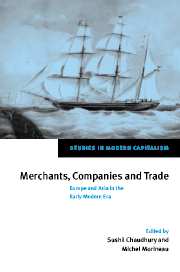Book contents
- Frontmatter
- Contents
- List of contributors
- Preface
- Introduction
- Part I Asia, especially India, around 1500
- Part II Routes, markets and merchants
- 3 The route through Quandahar: the significance of the overland trade from India to the West in the seventeenth century
- 4 The Armenian merchant network: overall autonomy and local integration
- 5 Commercial relations between India and the Ottoman Empire (late fifteenth to late eighteenth centuries): a few notes and hypotheses
- 6 Eastern and Western merchants from the sixteenth to the eighteenth centuries
- 7 The other ‘species’ world: speciation of commodities and moneys, and the knowledge-base of commerce, 1500–1900
- Part III European presence in Asia
- Part IV Implications of trade: Asia and Europe
- Index
3 - The route through Quandahar: the significance of the overland trade from India to the West in the seventeenth century
Published online by Cambridge University Press: 02 December 2009
- Frontmatter
- Contents
- List of contributors
- Preface
- Introduction
- Part I Asia, especially India, around 1500
- Part II Routes, markets and merchants
- 3 The route through Quandahar: the significance of the overland trade from India to the West in the seventeenth century
- 4 The Armenian merchant network: overall autonomy and local integration
- 5 Commercial relations between India and the Ottoman Empire (late fifteenth to late eighteenth centuries): a few notes and hypotheses
- 6 Eastern and Western merchants from the sixteenth to the eighteenth centuries
- 7 The other ‘species’ world: speciation of commodities and moneys, and the knowledge-base of commerce, 1500–1900
- Part III European presence in Asia
- Part IV Implications of trade: Asia and Europe
- Index
Summary
In recent years there has been a renewed interest among historians in the early modern trade from India towards the West. Frank Perlin has even observed that recent findings in monetary history, documenting the continued importance of the flow of precious metals through the Near and Middle East to India in the seventeenth century, implied ‘important revisions to the now conventional position represented by Steensgaard’. By this Perlin presumably means that I should have taken the point of view that the success of the Companies not only brought to an end the direct caravan trade between Asia and Europe through the Levant, but also the export trade from India to the Red Sea, the Persian Gulf and along the caravan routes. As far as I remember, I never discussed this particular problem, but concerning the trade to Persia I wrote in 1973: ‘The expansion of the Company trade in the first decades of the seventeenth century undoubtedly reduced the transit trade through the Persian Gulf, but it did not stop it. Neither was the fall of Hormuz able to stop the transit trade to the densely populated Safavid and Ottoman Empires. It was with this smaller, though far from negligible, transit trade that the Persian trade acquired its greatest significance after the fall of Hormuz.’
- Type
- Chapter
- Information
- Merchants, Companies and TradeEurope and Asia in the Early Modern Era, pp. 55 - 73Publisher: Cambridge University PressPrint publication year: 1999
- 3
- Cited by



